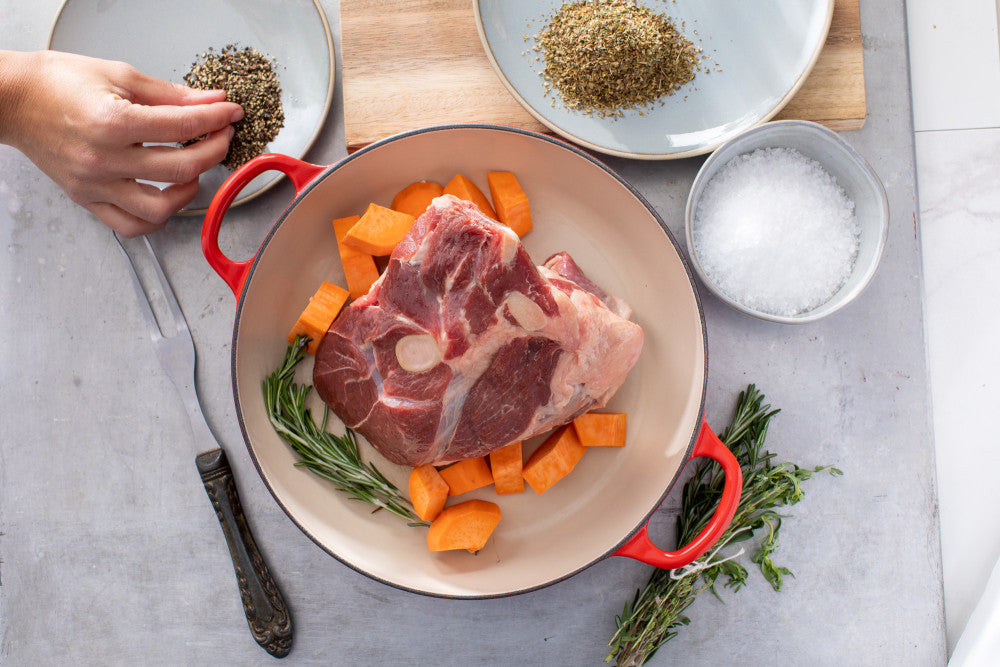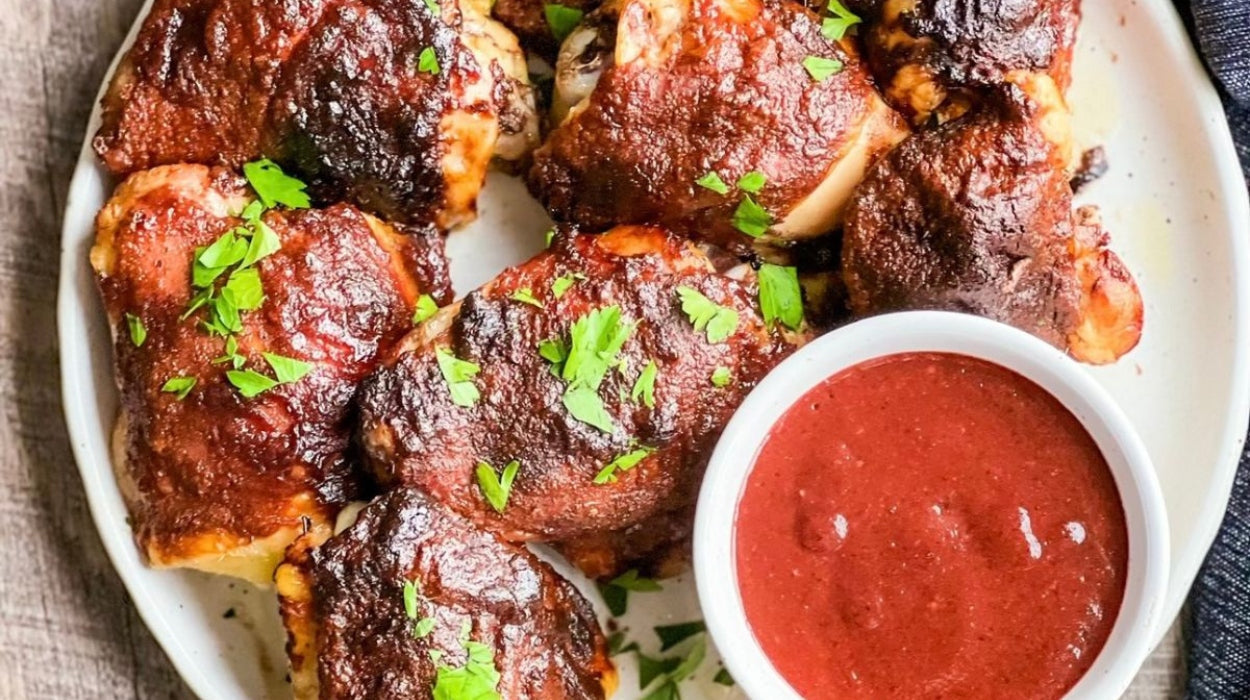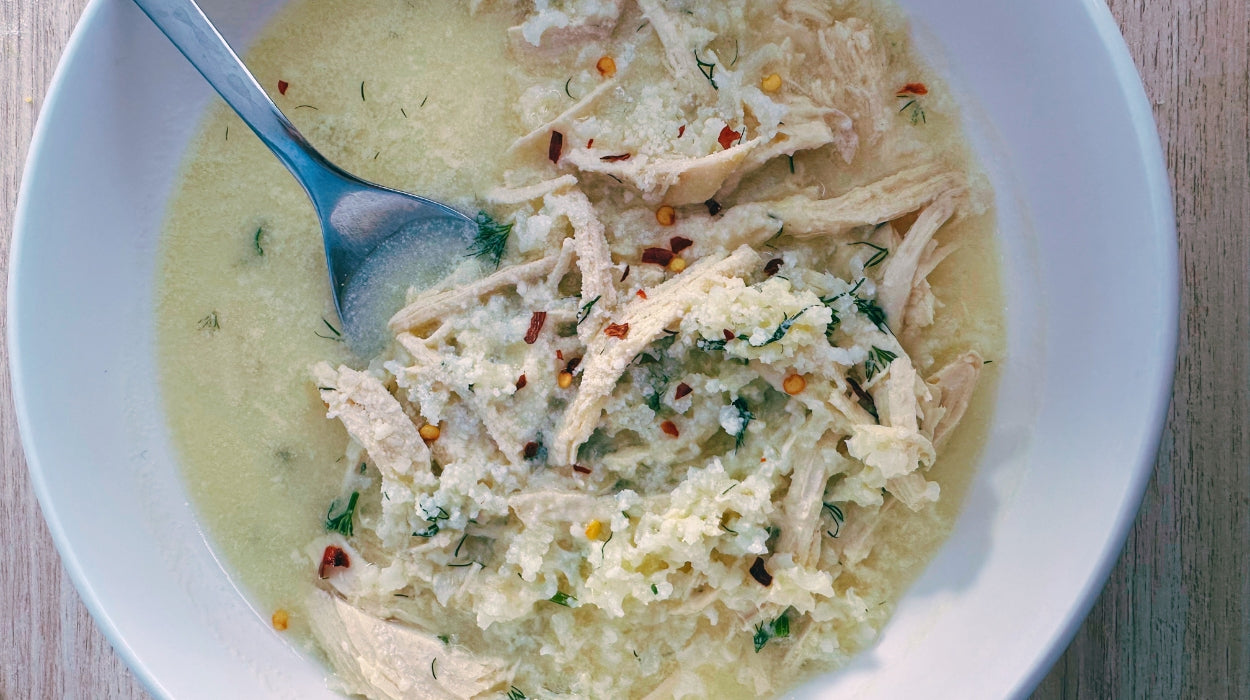5 Tips for a Flavorful & Tender Leg of Lamb Roast

A Simple and Elegant Celebratory Meal
If you're looking to serve a simple, elegant celebratory meal, look no farther. The leg of lamb roast, although it might sound intimidating, is an ideal roast for beginner home chefs. It’s foolproof with a tender and delicate flavor that makes pairing with seasonal vegetables effortlessly easy. Its approachable size and simplicity are perfect for stress-free hosting and intimate celebratory gatherings.
“A large portion of consumers say, ‘I love lamb, but I only eat it at restaurants. For many, preparing it is intimidating.” - Megan Wortman - Executive Director of the Denver-based American Lamb Board
This season, trade out the traditional turkey for a lamb if you’re looking for choices with additional health benefits. Lamb is very high in iron and when pasture-raised is also an extremely lean option with an average of only 160 calories per 3 ounces serving. It provides all nine essential amino acids your body needs for maintenance and includes a variety of health benefits, including immune system strength, nerve health, focus, energy, and metabolic health.
“There are misperceptions that lamb is fattier or higher in calories than it is, the nutrients and protein you get from lamb are nearly identical to beef. Lamb is ideal for people who want a lean protein.” - Megan Wortman - Executive Director of the Denver-based American Lamb Board
Raised the Grass Roots Way
Our lamb is 100% grass-fed and finished and GMO-free. Our sheep are raised outdoors, are moved to fresh pasture daily, and are never given antibiotics or growth hormones. Our farmers raise breeds known as "hair sheep"—which are known for producing the best meat. "Wool sheep—" another breed classification—produce a wax called lanolin that has an off-putting odor that can affect the flavor of the meat. Hair sheep do not produce lanolin. Their meat is lean and mild in flavor.
While more than half of the lamb available in conventional stores and sold in the USA is imported from Australia and New Zealand, the other half is driven by small-scale farmers like Grass Roots. Although raising lamb overseas can keep production costs low, local lambs have a much lower carbon footprint and of course, when you buy from USA based farms, you keep the money in the US economy.
Lamb are natural foragers, helping to manage the land by eating overgrowth and weeds. This foraging recycles nutrients in the soil without the use of any chemicals. As they move over the land they break up the soil and help spread seeds and allow water and nutrients to permeate, and because they do not have any top front teeth, when they pull on grass and weeds to eat, they do not pull out the roots of the plants, allowing easy regeneration. All of this works in rotation to build vital topsoil which sequesters carbon and slows climate change.
Tip #1 - Boneless or Bone-In?
A bone-in lamb leg can be a little trickier to carve but adds a richness in flavor. The meat of the bone-lamb is fattier, more tender, and the cut is more evenly shaped, making it easier to cook evenly. Using the bone from your roast for stock or bone broth is a great way to get the most nutritional value from your piece of meat. If you’re nervous about carving meat, boneless is a perfect option. You will need to use a heatproof and oven-safe netting or twine to keep the shape of the leg for cooking. Going boneless makes the roast lighter, so lifting is a bit easier.
3 Step Keto Lamb-Bone Broth Recipe
Lamb bone broth is a great replacement for beef, chicken, and vegetable stock in your favorite fall recipes. can be stored in the fridge for up to 1 week or frozen for up to 3 months:
-
Preheat the oven to 390F and place lamb bones into a roasting pan. Cook for 30-40 minutes, until well browned.
-
In a large stockpot, add the oil and place over medium heat. Add the onion, carrot, celery, garlic, thyme, and rosemary and saute for 5 minutes. Add the lamb bones and scrape any fat or juices from the roasting pan into the pot. Add 1 gallon of water and allow it to come to a simmer before reducing the heat to low.
-
Simmer for 8-24 hours uncovered, adding more water when the level drops. The amount of water you need will depend on how long you wish to cook the broth. After the broth is cooked for your desired length of time, strain the broth through a fine-mesh strainer. Enjoy hot or chill and use as desired.
Ingredients: 1 pound of Lamb Bones, 1 tablespoon of Olive Oil, 1-3 gallons of Water & kosher salt, 1 small onion (diced), 3 medium carrots (chopped), 3 sticks of celery (chopped) & 3 cloves of garlic and 3 sprigs of rosemary and 5 sprigs of Thyme
Bone-In Leg of Lamb Carving Instructions
You will need a cutting board and carving knife (optional: meat fork).
-
Placing the leg of lamb on the cutting board, with the largest side of facing up. You can cut a few slices from underneath the leg for more stability on the cutting board. With a meat fork or simply using your hands, secure the roast from the shank end. Make straight, parallel cuts straight down through the thickest part of the roast until you hit the bone (cutting across the grain of the meat, perpendicular to the bone). To get as much meat as possible, Keep your knife close to the bone, focus on cutting cleanly through the big slices.
-
At a 45-degree angle cut thin slices from the front rounded section of the leg roast. Working away from the shank, continue to slice. Rotating the leg to reveal the meatier section of the back section of the roast, continue to carve thin to medium slices. Starting at the shank end and keeping the knife parallel to the bone, continue to carve thin slices from the shank.
Tip #2 - Leg of Lamb Roast Seasoning Guide
Lamb has such a robust flavor, making it an ideal carrier for seasonings. Cuts from the shank, shoulder, and leg have more fat, creating a more grassy, well-balanced flavor. It’s full of juiciness and flavor because the sheep roam on pasture and the muscles get continuous blood flow, resulting in a more complex flavor than beef.
Roasted Leg of Lamb Simple Seasonings
Directions: Pat lamb dry with paper towels. Using a sharp knife, score the top side of the lamb by making shallow cuts all over.
Classic French: 1 tablespoon olive oil, 4 cloves garlic, minced, 1 tablespoon chopped fresh rosemary 1 tablespoon chopped fresh thyme leaves 1 tablespoon Dijon mustard, 1 tablespoon kosher salt, and 2 teaspoons ground black pepper
Mediterranean: 4 cloves garlic, minced, 1 tablespoon chopped fresh oregano, 1 tablespoon chopped fresh mint, 2 teaspoons nutmeg, 2 teaspoons paprika, 1 tablespoon olive oil, and Lemon juice
Artisan Rubs & Sea Salts
Finding curated gourmet seasonings can help save some time in the kitchen and space in your pantry. We partnered with Gustus Vitae, a California crafter of all-natural, sustainably sourced, Non-GMO Project Verified gourmet infused sea salts, fine seasonings and rubs, and naturally flavored artisan cane sugars. Crafted in small batches, free from artificial colors and flavors with hand-picked California local and imported ingredients. Interested in learning more about Gustus Vitae's products? Visit https://www.gustusvitae.com/
Farmhouse Perfect Protein Seasoning: Rosemary, Fennel, Oregano, Pepper, Marjoram, Sage, Coriander, Cinnamon, Cumin, Celery Seed, Ginger, Crushed Red Pepper, Salt, Garlic, Onion, Dill Weed, Parsley and Lemon Oil.
Garlic Pepper Rub: A lively blend of bold and zesty flavors, our authentic Garlic Pepper Rub adds full-bodied flavor. California Salt, Garlic, Black Pepper, Red Bell Pepper, Parsley.
Lemon Rosemary Sea Salt: Fresh, vibrant, sharp - these are some of the words that come to mind when describing our all-natural, small-batch Lemon Rosemary Sea Salt. Sea Salt, Lemon Peel, Lemon Zest, Rosemary.
Tip #3 - The Perfect Roast
Rare, Medium, or Well?
It’s all about personal preferences when cooking a leg of lamb roast. When cooking for a small group of family or friends, leaning on the medium-rare to medium side is a safe bet. The lamb will still be tender with a bit of pink but cooked thoroughly for picky eaters. Check hourly, until the lamb reaches your desired internal temperature. Add an extra 5-10 minutes for broil time, which will create a seared crust and another 15 minute after cooking for a resting period, the lamb will continue to cook internally
Roasting Temperature: 325°F
Rare: 125°F (about 15 minutes per pound)
Medium-Rare: 130°F to 135°F (about 20 minutes per pound)
Medium: 135°F to 140°F (about 25 minutes per pound)
Well-Done: 155°F to 165°F (about 30 minutes per pound)
Simple Leg of Lamb Roast
You will need: roasting pan, oven rack, foil or parchment paper, carving knife and meat thermometer
Roasting Temperature: 325°F
-
For quicker and even cooking, set your roast out an hour before cooking to reach room temperature. In a roasting pan lightly coated with olive oil, start by prepping your roast with olive oil, kosher salt, and fresh cracked pepper (season generously). Position your roast to face with the larger side down.
-
To create a crispy outer crust, broil in the oven for 5 minutes, positioning the lamb a few inches away from the broiler element. You’ll know the crust is ready when it looks seared and browned. Repeat on the other side.
-
Set your oven to 325°F and reposition the oven rack to the middle. At this point, season your roast with your rub of choice. Roast for an additional hour covering the lamb loosely with foil.
-
Check the internal temperature with an instant-read thermometer in the thickest part of the lamb (not touching bone), The lamb is ready when the temperature is 135°F or above. If the lamb is not ready, continue cooking uncovered until it reaches your desired internal temperature.
Tip #4 - Defrosting Your Leg of Lamb
Be extremely careful when handling raw foods, that it does not come in contact with other foods. There are two methods for thawing your leg of lamb roast. You can thaw your uncooked frozen lamb in the refrigerator, which will typically take around 24 hours to fully defrost. After thawing your roast will be safe in the refrigerator for up to three or four days. The other method is quicker, but a bit more hands-on. Make sure your frozen lamb is still tightly sealed in a freezer wrap or placed in a tightly-sealed bag. Submerge in a sink or pot filled with cold water, checking every 30 minutes. Cook immediately after thawing if you’re planning on using this method to cook your roast. The lamb is ready when the temperature is 135°F or above.
Tip #5 - Cooking Your Leg of Lamb From Frozen
First, preheat your oven to 300 to 375 F. Place the leg of lamb roast on a roasting pan and set on the middle or roasting rack. Cooking for an additional 50% longer than you would your thawed roast based on your preferences. The lamb is ready when the temperature is 135°F or above.
You Can’t Go Wrong with Lamb
If you're looking to serve a simple, elegant celebratory meal, choosing a bone-in or boneless leg of lamb roast is an excellent way to familiarize yourself when working with lamb in the kitchen. Roast slowly at a low temperature to preserve all the tenderness lamb is famous for and get creative with spices and marinades. Lamb roasts are affordable and foolproof with a tender and delicate flavor - a crowd-pleaser for even the pickiest of eaters.
Utensils
Recent Posts






